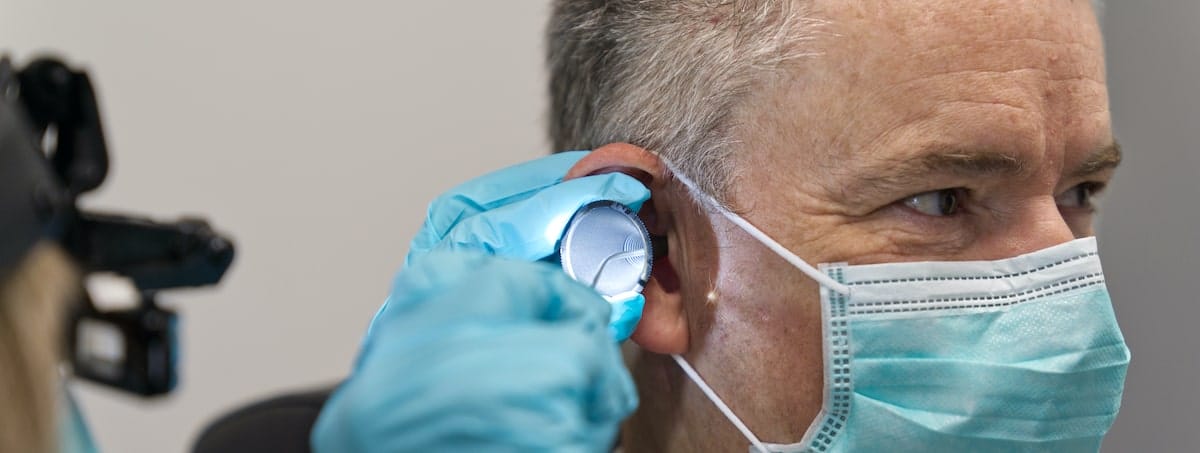Why You Should Choose Us?
It comes down to audiology and health professionals like us with the experience and best equipment in a suitable environment to lead the way when it comes to a procedure like ear wax removal. It is our mission to ensure safe practice and recommended guidelines in the best clinical space.
What we offer is the ‘Gold Standard’, safety and comfort first, the highest professional standards from our very experienced practitioners, with a fast and efficient service.
We only employ fully qualified, insured and registered experienced ear care professionals. (Our five qualified professionals have a combined background in NHS and private health and audiology of nearly 150 years!).
Clinical Environment
 There is no recommended environment to carry out ear wax removal. We see some providers offering a mobile service, this is possible but not something we particularly encourage. There are too many variables that can lessen the safety and efficiency of the procedure of ear wax removal.
There is no recommended environment to carry out ear wax removal. We see some providers offering a mobile service, this is possible but not something we particularly encourage. There are too many variables that can lessen the safety and efficiency of the procedure of ear wax removal.
We have a specially designated ear wax removal room at our clinic in Silsden. It is fitted out specifically for the purpose with all the best equipment needed to deliver on our ‘Gold Standard’. We have a high level of control when it comes to health and hygiene.
As an audiology company we have a long heritage of looking after peoples ears and hearing!
Safety first, please don’t cut corners!
Surprisingly there is scant regulation when it comes to ear wax removal. You may have seen low cost devices on Amazon / eBay or your Facebook feed to ‘do it yourself’. You may have considered or even used Hopi ear candles via an alternative health clinic.
We recommend neither, both can be considered at best ineffective and actually potentially dangerous to your well being….
Also, there are unbelievably people out there supplying a wax removal service that are what we would consider unqualified with little to no formal or recognised training, ill equipped to safely remove the wax from your blocked ears.
The only roadblock currently stopping anyone from carrying out ear wax removal is whether or not that person can obtain insurance and can attend a two day course. They could still technically practice without insurance but of course this would leave them open to criminal prosecution.
The Procedure
With every ear wax removal customer we follow a number of processes and it tends to be in this order;
Otoscopy
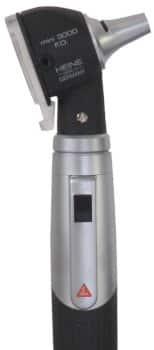 With an otoscope (hand held magnification with bright light) we inspect each ear canal to check how much wax and debris is present. We always carry out otoscopy on both ears even if you only complain of one ear being blocked with ear wax.
With an otoscope (hand held magnification with bright light) we inspect each ear canal to check how much wax and debris is present. We always carry out otoscopy on both ears even if you only complain of one ear being blocked with ear wax.
It is surprising how often one ear is nearly as blocked as the other!
Competent clinical examination of the ear is essential. Correct procedure is essential to make sure we diagnose what is happening in the ear canal. The ear canal can tell us so many things regarding your health.
The most common ear disorder we routinely see is impacted ear wax. However, we are always looking out for other more serious conditions which can on occasion lead us to a GP or ENT referral.
Your ear drum is essentially a window into your middle ear and inspection can provide a trained professional with valuable information. The appearance and behaviour of the ear drum can be an indicator of your ear health and raise a flag to underlying issues.
If you are uncertain, we are always happy to offer you full clinical otoscopy and a complete ear health check.
Video Otoscopy and Consent Form
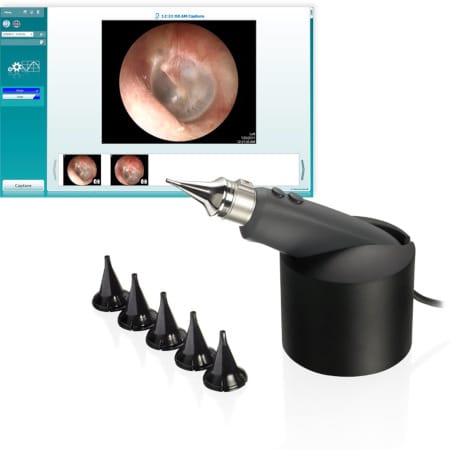 At our clinic we can perform video otoscopy. Basically with this equipment we can project an image of the state of your ear canal and ear drum on to a screen, and you can see the image too if you like!
At our clinic we can perform video otoscopy. Basically with this equipment we can project an image of the state of your ear canal and ear drum on to a screen, and you can see the image too if you like!
Video otoscopy will allow you to see what we are seeing, although it’s not everybody’s cup of tea looking at their own ear canal….
What it can do is help you satisfy yourself that your ears are blocked and need clearing.
Also, if we see anything that particularly worries us we can take a snapshot image, store it on your secure digital file at our premises, and even perhaps forward the image on to your GP if a referral is necessary.
The next thing we do is explain the various procedures to you and talk about any risk factors.
We ask you various questions about your ears and health to ensure we can perform the procedure of ear wax removal safely and comfortably.
For instance we need to know of any history of perforated ear drums, ongoing ear infections and other ear health issues that can potentially affect the various methods of ear wax removal available.
Ear Wax Removal – Microsuction
The next step is to remove the ear wax from your ears. Our preference is by microsuction, the gold standard method generally accepted to be the safest, quickest and most comfortable.
Our microsuction machine is quite noisy. We will prepare you for this but you will get used to it very quickly. We begin by removing any earwax that is on the edge of the canal. We tend to work around the edges as this is where the ear wax is at its softest.
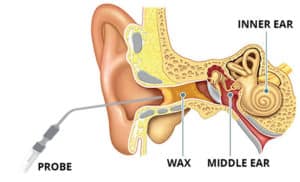 During the ear wax removal procedure you will hear an audible change the microsuction machine makes. This happens when the machine grabs the ear wax and sends it up the suction probe.
During the ear wax removal procedure you will hear an audible change the microsuction machine makes. This happens when the machine grabs the ear wax and sends it up the suction probe.
Before and as we remove the impacted ear wax we may add some olive oil. Applying 2-3 days of oil morning and evening before your appointment ensures the wax removal is more comfortable and increases the chance of the procedure being completed on the day (as opposed to a second visit being required!).
The olive oil (we favour the brand ‘Earol’) helps lubricate your ear canals and helps the microsuction machine suction probe grab hold of the ear wax.
As we get deeper down the ear canal we will stop from time to time and just check in with you and make sure you are ok.
We will ask you about the noise of the microsuction machine and then we will ask you if you are ok and if the ear wax removal procedure is free from discomfort.
Ear Wax Removal – Other Methods
Sometimes the ear wax and blockage is not easily removed using microsuction alone. This can be for a variety of reasons.
- Very impacted ear wax too hard to breakdown still stuck in ear or causing discomfort.
- Ear wax is very deep and there is no certainty of the ear wax and its proximity to the ear drum.
- Ear Wax is very oily and you can’t remove it with a microsuction machine suction probe.
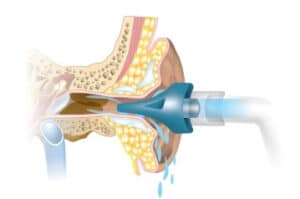 Your safety is paramount and we don’t want to risk discomfort. It is rare that we send people away for a return visit but please be aware that if we do it’s only because we are thinking of your comfort and safety.
Your safety is paramount and we don’t want to risk discomfort. It is rare that we send people away for a return visit but please be aware that if we do it’s only because we are thinking of your comfort and safety.
If the wax in your ear canal is quite soft we will sometimes choose to irrigate your ear to remove the wax. Irrigation is a gentle procedure involving controlled streams of water directed at your ear canal as opposed to your ear drum.
The water is temperature checked to be around body temperature (37 degrees for comfort and safety – as always). The water runs around the ear canal and brings the remainder of the soft ear wax out of the canal into a receptacle called a ‘noots tank’.
 There is also another method we occasionally use called ‘dry removal’ where necessary. We sometimes use a Jobson Horne probe or Henkel / Crocodile forceps to remove hard and loose objects in the ear canal. That could be a hard lump of loose wax, or a foreign object that should not belong in the ear canal. End of a cotton bud (please don’t use cotton buds!), a hearing aid wax filter, anything you might put into your ear canal that you shouldn’t.
There is also another method we occasionally use called ‘dry removal’ where necessary. We sometimes use a Jobson Horne probe or Henkel / Crocodile forceps to remove hard and loose objects in the ear canal. That could be a hard lump of loose wax, or a foreign object that should not belong in the ear canal. End of a cotton bud (please don’t use cotton buds!), a hearing aid wax filter, anything you might put into your ear canal that you shouldn’t.
The old saying holds well, never put anything in your ear smaller than your own elbow! leave it to the experts, we can see what we are doing….
Once the ear wax removal procedure has been completed we then re-inspect the ear canal with Otoscopy / Video Otoscopy to make sure all is well, and offer any relevant additional advice to manage future problems with ear wax blockage.
Please note – All our staff have undertaken training in debris and wax removal and will use best-practice procedures to minimise any risk of harm. However, as with any wax removal procedure, even when performed with the utmost care, there is a small risk of damage to or infection of the skin of the ear canal or the eardrum.
Furthermore, the procedures of microsuction and water irrigation can be noisy and may cause a temporary shift in your hearing thresholds or start / aggravate any existing tinnitus. There is also the risk of temporary dizziness or discomfort.
Application of olive oil may be used during the procedure unless there is a known sensitivity. Where it is not possible to remove the wax you may be advised to apply more olive oil or similar before arranging a further visit.

